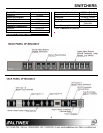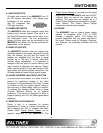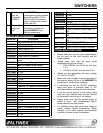
SWITCHERS
7
7.3 RS-232 CONTROL
A computer through RS-232 port can remotely
control the MX2426CV. A terminal block
connector is used to
make interconnection in
the field easy. The RS-
232 commands are
written using ASCII
character format. This makes it simple to
program and control the MX2426CV.
The terminal block is labeled with the proper
contact designations: Transmit (TX), Receive
(RX), and Ground (GND). Always remember that
the Transmit pin from the control system or
computer must be connected to the Receive pin
on the switcher control port; do not connect
Transmit to Transmit or Receive to Receive.
Typically, a control system or computer will offer
an RS-232 connection on a 9-pin D connector.
The following are two typical cable pin-out
designations for RS-232 connections. Always
confirm the pin-outs for your system to insure
proper wiring.
IBM PIN No.
MX2426CV Contact
3 RX
2 TX
7 GND
Connection IBM-PC 25-pin D to MX2426CV
Terminal Block
IBM PIN No.
MX2426CV Contact
2 TX
3 RX
5 GND
Connection IBM-PC 9-pin D to MX2426CV
Terminal Block
Port setting preferences for the control system or
computer being used to control the switcher
should be set as follows:
BAUD Rate (Bits per second): 2400
Data Bits: 8
Parity: None
Stop Bits 1
There is no software or hardware flow control
implemented. The RS-232 input has a 6-
character buffer and will not execute additional
commands until the previous command is fully
processed.
7.4 RS-232 PROTOCOL:
Standard RS-232 is used to control the switcher.
Control can be accomplished either through a
computer or through a control system.
RS-232 Protocol:
[AOFF] All channels off. Turns all monitor
outputs off. This command does not
affect source selection.
[RSET] Resets the unit to the POWER ON
condition. During POWER ON all
monitors are turned OFF. This is done
to preclude accidental monitor
connection during the power glitch.
[FSET] This command initializes the unit to
the factory condition. All memories are
reset. Do not use this command
unless it is absolutely necessary.
[INP0] Turns all input sources to the OFF
position. After executing this
command input 1 and input 2 are
disconnected from the outputs.
[INP1] Select input 1. This is the Plaintiff
side.
[INP2] Select input 2. This is the Defendant
side.













